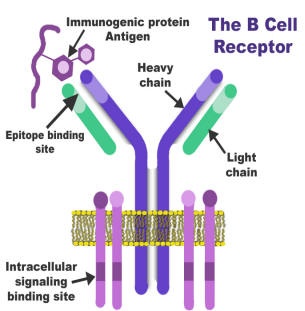Overview B-cell receptors (BCRs) are unique in their ability to recognize a highly specific antigen and produce an intracellular response. Centering around a membrane-bound IgM antibody which performs the actual antigen detection, they also contain a number of helper proteins, in particular the membrane proteins CD79A and CD79B; inside the cell, protein kinases such as Lyn attach to their intracellular domains to receive any signal it transmits. For this project, we plan to engineer a BCR to respond to the beta-amyloid plaques that are the hallmark of Alzheimer's disease. Normally, when an antigen binds to the IgM part of the BCR, CD79A and CD79B become phosphorylated with the help of Lyn, thus recruiting another protein kinase known as Syk. In B cells, this leads to a signaling cascade which induces cell proliferation. In our circuit, we would like the binding of beta-amyloid to transmit a signal in the form of a transcription factor to our diagnosis/treatment module - although this cuts out the signal amplification resulting from the kinase cascade, it leads to a far more controlled and quantifiable cellular response. Our solution involves TEV protease, which cleaves a particular amino acid sequence (TEV cleavage site) that can be used as a linker in fusion proteins. In our system, CD79A and CD79B are linked to transcription factors by TEV cleavage sites and Syk is fused to a TEV protease. When Syk is recruited to the BCR upon beta-amyloid binding, the attached TEV protease will come in close proximity to its cleavage site, where it can cut and release the attached transcription factor into the cell. This transcription factor can then go on to activate the genes involved in our diagnosis/treatment module. Additionally, by a simple substitution our modified BCR could be adapted to detect any antigen (and release any transcription factor), making it a particularly useful synthetic biology tool.
Alternative Uses Can sense anything Of potential use to DoD: sensors for bio terrorism. Take our amplification testbed circuit, throw in sensors for biological weaopons. If there is a biological attack, you would find out way before symptoms develop. Keeping cells alive is relatively cheap (especially if this works in yeast), should be cheap enough to roll out. Could also potentially make antibodies to certain chemical agents. |
|---|
To Do sat: retransform Lyn and the gibsons (gibson cultures ought not exceed 30C) Friday
|
|---|
Proteins needed |
|---|
Links To EVERYTHING!


